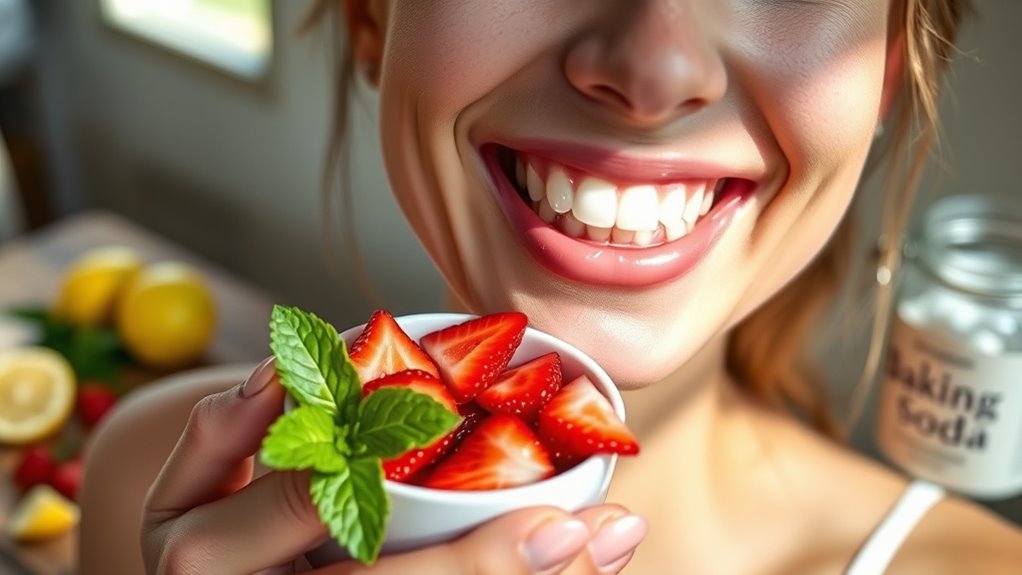To naturally whiten your teeth at home, focus on good oral hygiene by brushing, flossing, and rinsing regularly. Incorporate crunchy fruits and vegetables like apples and carrots, which help clean surfaces, and use baking soda in moderation to remove stains gently. Try swishing with hydrogen peroxide or oil pulling with coconut oil for extra whitening benefits. Using activated charcoal and rinsing with apple cider vinegar may help too. Keep these methods consistent, and you’ll discover more effective tricks to brighten your smile.
Key Takeaways
- Maintain good oral hygiene by brushing, flossing, and rinsing with antibacterial mouthwash regularly.
- Incorporate whitening fruits and vegetables like apples, carrots, and crunchy greens into your diet.
- Use natural substances such as baking soda and activated charcoal cautiously to remove surface stains.
- Rinse with diluted hydrogen peroxide and practice oil pulling with coconut oil for stain reduction.
- Limit acidic and abrasive foods, and support enamel health to prevent damage and enhance whitening results.
Maintain a Bright Smile With Proper Oral Hygiene

Maintaining a bright smile starts with good oral hygiene habits. When you prioritize your dental health, you prevent plaque buildup and staining that can dull your teeth. Regular brushing twice a day with fluoride toothpaste removes food particles and bacteria, keeping your teeth clean and healthy. Floss daily to eliminate debris from hard-to-reach areas, reducing the risk of cavities and discoloration. Don’t forget to rinse with an antibacterial mouthwash to control bacteria and freshen your breath. Consistent oral hygiene not only maintains your dental health but also helps keep your smile naturally bright. Incorporating proper oral hygiene techniques into your routine can enhance the effectiveness of your whitening efforts. By making these habits part of your routine, you set a strong foundation for whiter teeth and a confident, radiant smile.
Incorporate Whitening Fruits and Vegetables Into Your Diet
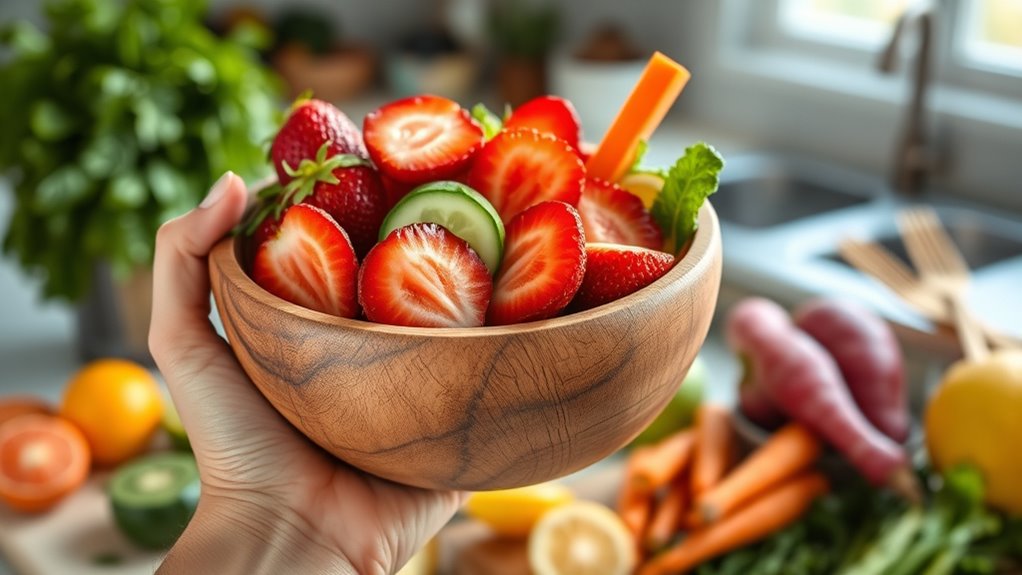
Eating crunchy fruits and vegetables can naturally help whiten your teeth. These foods contain enzymes that break down stains and scrub away plaque. Incorporating them into your diet is an easy, tasty way to boost your smile’s brightness. For added nutritional benefits, consider including chia seeds in your meals, as they are rich in antioxidants and promote overall oral health.
Crunchy Produce Benefits
Incorporating crunchy fruits and vegetables into your diet can naturally help whiten your teeth. Kale benefits your oral health by providing fiber that scrapes away plaque and surface stains. Carrots advantages include their high vitamin A content, which promotes healthy gums, and their crunchy texture that acts like a natural toothbrush. Biting into these produce items stimulates saliva production, which helps wash away food particles and bacteria that cause staining. Their fibrous nature gently cleans the teeth’s surface, reducing discoloration over time. Plus, eating a variety of crunchy produce supports overall oral health, making your smile brighter and cleaner. Regularly consuming these foods can also enhance your digital literacy, allowing you to better understand and utilize health information online. By making these foods a regular part of your diet, you can enjoy the benefits of natural teeth whitening without harsh chemicals.
Natural Enzymes Action
Since natural enzymes can help break down stains and whiten teeth, adding enzyme-rich fruits and vegetables to your diet is a smart move. Enzymes in oral care facilitate enzymatic stain removal, making your teeth appear brighter naturally. To maximize these benefits, consider:
- Snacking on pineapple, which contains bromelain, an enzyme that aids enzymatic stain removal.
- Incorporating papaya into your meals for its papain enzyme, known for its gentle cleaning action.
- Eating crunchy apples to stimulate saliva and boost enzymes that fight plaque.
- Enjoying carrots and celery as natural scrapers that support the enzymes in oral care.
- Including a variety of yoga practices to improve overall well-being and reduce stress, which can indirectly support oral health through better habits.
Together, these foods enhance enzymatic stain removal and contribute to a healthier, whiter smile through natural enzyme action.
Use Baking Soda as a Natural Tooth Whitener
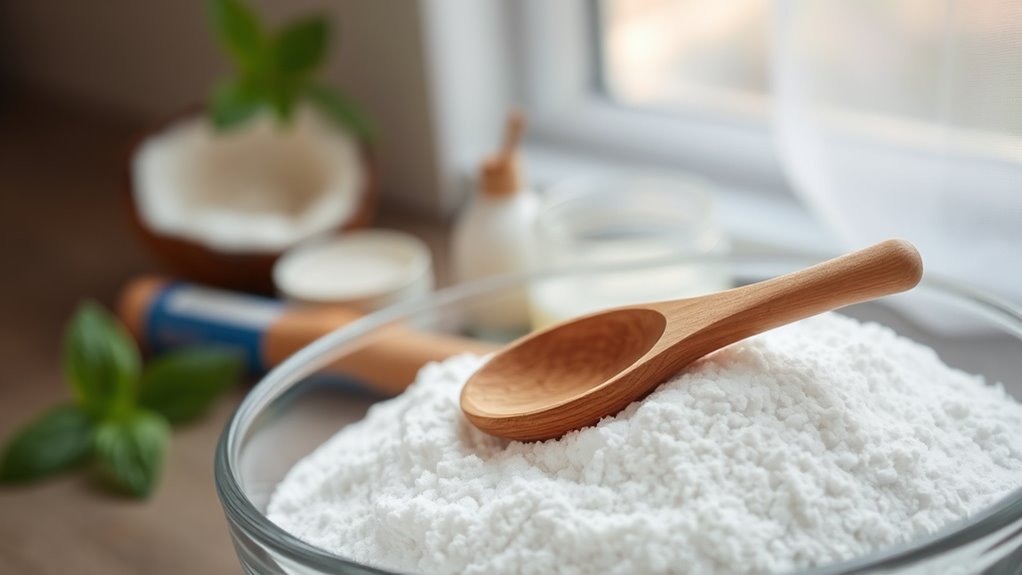
Baking soda is a popular natural tooth whitener because of its abrasive and alkaline properties. To use it safely, you should know the proper application technique and be aware of potential teeth sensitivity. Let’s explore how to effectively incorporate it into your oral care routine. Maintaining proper oral hygiene practices can enhance whitening results and promote overall dental health.
Baking Soda Composition
Baking soda, or sodium bicarbonate, is a popular natural remedy for whitening teeth because of its gentle abrasive properties. Its composition includes a simple chemical structure that makes it effective for cleaning and improving dental health. When you look at baking soda, you’ll notice it’s made up of:
- Sodium ions, which help neutralize acids in your mouth
- Bicarbonate ions, responsible for its alkaline nature
- Water molecules, enabling it to dissolve easily
- Trace minerals, which may support overall oral health
These components contribute to baking soda benefits, such as removing surface stains and reducing acidity. Its composition makes it a safe, cost-effective option for maintaining dental health while gently whitening your teeth at home. Additionally, the mild abrasiveness of baking soda helps scrub away surface stains, making it an effective natural whitening agent.
Proper Application Technique
To effectively whiten your teeth with baking soda at home, it’s important to follow the proper application technique. Consistency is key; use it 2-3 times weekly for best results. First, select a soft-bristled toothbrush to avoid gum irritation. Dampen your brush, then dip it into a small amount of baking soda—about a pea-sized amount suffices. Gently brush your teeth in circular motions for 2 minutes, focusing on stained areas. Rinse thoroughly afterward. Here’s a quick guide:
| Step | Action |
|---|---|
| 1 | Choose soft-bristled brush |
| 2 | Dampen brush, dip in soda |
| 3 | Brush gently in circles |
| 4 | Rinse mouth thoroughly |
Following this technique ensures safe, effective whitening while minimizing sensitivity risks. Additionally, understanding the proper application technique can help prevent overuse and protect your dental health.
Potential Teeth Sensitivity
While baking soda is a popular natural teeth whitener, it can sometimes cause increased sensitivity for some people. This sensitivity often results from tooth enamel erosion or gum recession, exposing nerve endings. To minimize risks, be cautious with baking soda use. Here are four points to contemplate:
- Overuse can wear down your tooth enamel, making teeth more sensitive.
- Aggressive brushing with baking soda may irritate gums, leading to recession.
- Using a paste with too much baking soda increases the risk of erosion.
- People with existing sensitivity or gum issues should consult a dentist before trying this method.
- Incorporating AI advancements in dental care, such as AI-powered diagnostic tools, can help assess individual sensitivity levels before attempting whitening methods.
If you notice increased discomfort, stop using baking soda immediately and seek professional advice. Proper application and moderation are key to avoiding potential sensitivity issues.
Try Hydrogen Peroxide for Safe and Effective Whitening
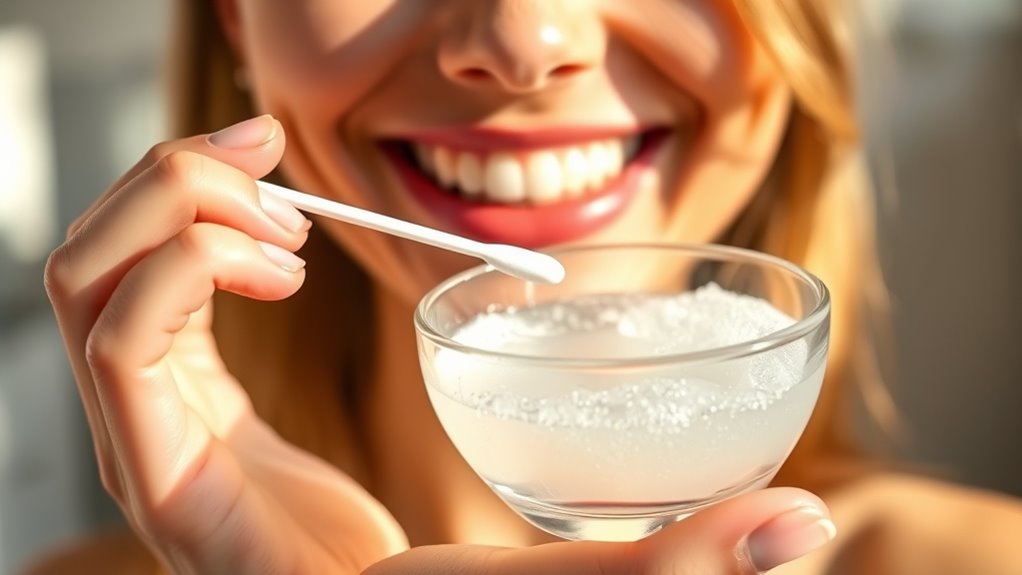
Hydrogen peroxide is a popular natural remedy for whitening teeth because it acts as a mild bleaching agent. When used properly, it can effectively remove dental stains and brighten your smile. To try it safely, mix equal parts hydrogen peroxide and water, then swish the solution in your mouth for about 30 seconds. This helps with dental stain removal and also aids in controlling mouth bacteria, promoting overall oral health. Be careful not to swallow the mixture, and avoid overusing it—doing this once or twice a week is sufficient. Hydrogen peroxide is a simple, cost-effective approach to achieving a whiter smile while supporting oral hygiene. Just remember, if you experience sensitivity or irritation, discontinue use and consult your dentist. Many people also incorporate live music venues into their dining experiences, which can make your time at home more enjoyable.
Apply Coconut Oil Pulling for Oral Detoxification
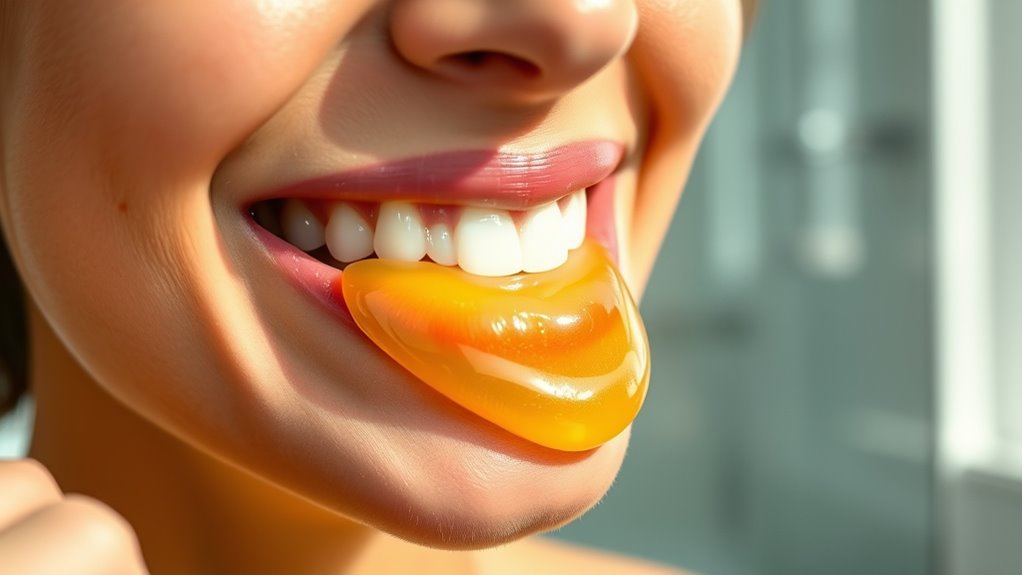
Coconut oil pulling is a simple, natural method to support oral detoxification and improve your smile. When you swish coconut oil in your mouth, you’re tapping into its numerous coconut oil benefits, including reducing bacteria and toxins. Here’s what you do:
Coconut oil pulling naturally detoxifies your mouth and brightens your smile.
- Take a tablespoon of coconut oil.
- Swish it around your mouth for 15-20 minutes, ensuring it reaches all areas.
- Spit out the oil, avoiding swallowing.
- Rinse your mouth thoroughly with water and brush as usual.
This process helps loosen plaque, eliminate harmful bacteria, and promote a healthier mouth. Regular coconut oil pulling supports oral detoxification, leaving your teeth brighter and your breath fresher. It’s a natural, affordable way to boost your oral health at home. Additionally, maintaining good oral hygiene practices aligned with preventive dental care can enhance overall results.
Utilize Activated Charcoal to Remove Surface Stains
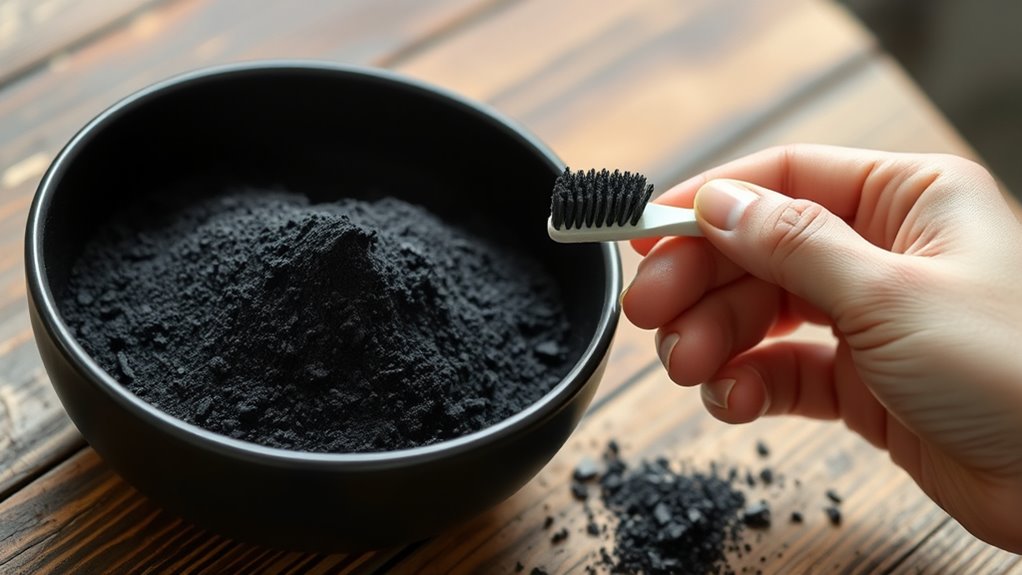
Activated charcoal is a popular natural remedy for removing surface stains and brightening your teeth. To use it, start with a small amount of charcoal powder and dip a damp toothbrush into it. Charcoal application involves gently brushing your teeth in circular motions for about two minutes. This process helps lift surface stain removal by吸吸吸吸吸吸吸吸吸吸吸吸吸吸吸吸吸吸吸吸吸吸吸吸吸吸吸吸吸吸吸吸吸吸吸吸吸吸吸吸吸吸吸吸吸吸吸吸吸吸吸吸吸吸吸吸吸吸吸吸吸吸吸吸吸吸吸吸吸吸吸吸吸吸吸吸吸吸吸吸吸吸吸吸吸吸吸吸吸吸吸吸吸吸吸吸吸吸吸吸吸吸吸吸吸吸吸吸吸吸吸吸吸吸吸吸吸吸吸吸吸吸吸吸吸吸吸吸吸吸吸吸吸吸吸吸吸吸吸吸吸吸吸吸吸吸吸吸吸吸吸吸吸吸吸吸吸吸吸吸吸吸吸吸吸吸吸吸吸吸吸吸吸吸吸吸吸吸吸吸吸吸吸吸吸吸吸吸吸吸吸吸吸吸吸吸吸吸吸吸吸吸吸吸吸吸吸吸吸吸吸吸吸吸吸吸吸吸吸吸吸吸吸吸吸吸吸吸吸吸吸吸吸吸吸吸吸吸吸吸吸吸吸吸吸吸吸吸吸吸吸吸吸吸吸吸吸吸吸吸吸吸吸吸吸吸吸吸吸吸吸吸吸吸吸吸吸吸吸吸吸吸吸吸吸吸吸吸吸吸吸吸吸吸吸吸吸吸吸吸吸吸吸吸吸吸吸吸吸吸吸吸吸吸吸吸吸吸吸吸吸吸吸吸吸吸吸吸吸吸吸吸吸吸吸吸吸吸吸吸吸吸吸吸吸吸吸吸吸吸吸吸吸吸吸吸吸吸吸吸吸吸吸吸吸吸吸吸吸吸吸吸吸吸吸吸吸吸吸吸吸吸吸吸吸吸吸吸吸吸吸吸吸吸吸吸吸吸吸吸吸吸吸吸吸吸吸吸吸吸吸吸吸吸吸吸吸吸吸吸吸吸吸吸吸吸吸吸吸吸吸吸吸吸吸吸吸吸吸吸吸吸吸吸吸吸吸吸吸吸吸吸吸吸吸吸吸吸吸吸吸吸吸吸吸吸吸吸吸吸吸吸吸吸吸吸吸吸吸吸吸吸吸吸吸吸吸吸吸吸吸吸吸吸吸吸吸吸吸吸吸吸吸吸吸吸吸吸吸吸吸吸吸吸吸吸吸吸吸吸吸吸吸吸吸吸吸吸吸吸吸吸吸吸吸吸吸吸吸吸吸吸吸吸吸吸吸吸吸吸吸吸吸吸吸吸吸吸吸吸吸吸吸吸吸吸吸吸吸吸吸吸吸吸吸吸吸吸吸吸吸吸吸吸吸吸吸吸吸吸吸吸吸吸吸吸吸吸吸吸吸吸吸吸吸吸吸吸吸吸吸吸吸吸吸吸吸吸吸吸吸吸吸吸吸吸吸吸吸吸吸吸吸吸吸吸吸吸吸吸吸吸吸吸吸吸吸吸吸吸吸吸吸吸吸吸吸吸吸吸吸吸吸吸吸吸吸吸吸吸吸吸吸吸吸吸吸吸吸吸吸吸吸吸吸吸吸吸吸吸吸吸吸吸吸吸吸吸吸吸吸吸吸吸吸吸吸吸吸吸吸吸吸吸吸吸吸吸吸吸吸吸吸吸吸吸吸吸吸吸吸吸吸吸吸吸吸吸吸吸吸吸吸吸吸吸吸吸吸吸吸吸吸吸吸吸吸吸吸吸吸吸吸吸吸吸吸吸吸吸吸吸吸吸吸吸吸吸吸吸吸吸吸吸吸吸吸吸吸吸吸吸吸吸吸吸吸吸吸吸吸吸吸吸吸吸吸吸吸吸吸吸吸吸吸吸吸吸吸吸吸吸吸吸吸吸吸吸吸吸吸吸吸吸吸吸吸吸吸吸吸吸吸吸吸吸吸吸吸吸吸吸吸吸吸吸吸吸吸吸吸吸吸吸吸吸吸吸吸吸吸吸吸吸吸吸吸吸吸吸吸吸吸吸吸吸吸吸吸吸吸吸吸吸吸吸吸吸吸吸吸吸吸吸吸吸吸吸吸吸吸吸吸吸吸吸吸吸吸吸吸吸吸吸吸吸吸吸吸吸吸吸吸吸吸吸吸吸吸吸吸吸吸吸吸吸吸吸吸吸吸吸吸吸吸吸吸吸吸吸吸吸吸吸吸吸吸吸吸吸吸吸吸吸吸吸吸吸吸吸吸吸吸吸吸吸吸吸吸吸吸吸吸吸吸吸吸吸吸吸吸吸吸吸吸吸吸吸吸吸吸吸吸吸吸吸吸吸吸吸吸吸吸吸吸吸吸吸吸吸吸吸吸吸吸吸吸吸吸吸吸吸吸吸吸吸吸吸吸吸吸吸吸吸吸吸吸吸吸吸吸吸吸吸吸吸吸吸吸吸吸吸吸吸吸吸吸吸吸吸吸吸吸吸吸吸吸吸吸吸吸吸吸吸吸吸吸吸吸吸吸吸吸吸吸吸吸吸吸吸吸吸吸吸吸吸吸吸吸吸吸吸吸吸吸吸吸吸吸吸吸吸吸吸吸吸吸吸吸吸吸吸吸吸吸吸吸吸吸吸吸吸吸吸吸吸吸吸吸吸吸吸吸吸吸吸吸吸吸吸吸吸吸吸吸吸吸吸吸吸吸吸吸吸吸吸吸吸吸吸吸吸吸吸吸吸吸吸吸吸吸吸吸吸吸吸吸吸吸吸吸吸吸吸吸吸吸吸吸吸吸吸吸吸吸吸吸吸吸吸吸吸吸吸吸吸吸吸吸吸吸吸吸吸吸吸吸吸吸吸吸吸吸吸吸吸吸吸吸吸吸吸吸吸吸吸吸吸吸吸吸吸
Practice Regularly Rinsing With Apple Cider Vinegar

Practicing regular rinsing with apple cider vinegar can help improve your oral health and whiten your teeth naturally. It works by reducing dental plaque and promoting enamel health. To get the best results, consider these steps:
- Dilute one tablespoon of apple cider vinegar in a cup of water to prevent enamel erosion.
- Rinse your mouth with the mixture for about 30 seconds, ensuring it touches all surfaces.
- Spit out the rinse and avoid eating or drinking for 30 minutes afterward to protect your enamel.
- Limit this routine to 2-3 times per week to avoid damaging your teeth.
Regular rinsing can help break down plaque buildup and brighten teeth, but overdoing it may harm enamel, so moderation is key.
Frequently Asked Questions
Are Natural Teeth Whitening Methods Safe for Sensitive Teeth?
If you’re concerned about sensitivity concerns, natural teeth whitening methods can be safe if you choose ingredients carefully. Look for gentle options like baking soda or hydrogen peroxide in low concentrations, and avoid harsh abrasives. Always check ingredient safety and start with small tests to prevent irritation. If you experience discomfort, stop immediately and consult your dentist. Natural methods can be effective without aggravating sensitive teeth when used properly.
How Long Does It Take to See Results From Home Whitening?
Imagine you use a baking soda and hydrogen peroxide paste; within a week, you might notice slight improvements. Timing expectations vary, but typically, you’ll see results in about 1-2 weeks with consistent use. Treatment duration depends on your teeth’s condition and chosen method. For noticeable whitening, stick to your routine daily, and you could achieve brighter teeth in just a couple of weeks.
Can Natural Remedies Cause Any Long-Term Damage to Enamel?
You might wonder if natural remedies cause long-term damage like tooth sensitivity or enamel erosion. While many natural options are gentle, overusing acidic substances like lemon juice or baking soda can wear down your enamel, leading to sensitivity and erosion. Always use these remedies sparingly and consult your dentist if you notice discomfort or increased sensitivity. Proper care helps keep your enamel healthy while achieving a brighter smile.
Are There Any Side Effects From Using Activated Charcoal or Baking Soda?
Did you know 30% of people experience tooth sensitivity when using whitening methods? When considering activated charcoal safety, it’s important to know it can be abrasive and may wear down enamel if overused. Baking soda risks include gum irritation and enamel erosion. Both can cause side effects like increased sensitivity or damage if not used properly. Always consult your dentist before trying these natural remedies for whitening.
How Often Should I Practice These Home Whitening Techniques?
You should consider the frequency of application and ideal timing carefully to avoid damaging your teeth. For most natural whitening methods like baking soda or activated charcoal, using them 2-3 times a week is sufficient. Applying them too often can cause enamel erosion. It’s best to do treatments in the morning or evening, but always listen to your teeth’s response, and consult a dentist for personalized advice.
Conclusion
So, there you have it—your foolproof, all-natural toolkit for a dazzling smile without draining your wallet or turning your mouth into a chemistry lab. Just remember, patience is key, and overdoing it might turn your teeth into a science experiment. Who knew dazzling whites could be so easy and fun? Now go ahead, impress everyone with your radiant grin—just maybe skip the charcoal at your next dinner party. Your teeth (and your guests) will thank you.
